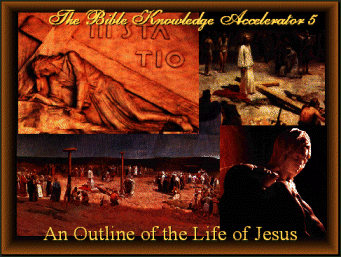

 |

| S | econd Visitors - Magi |
Matthew 2:1-12 Historical
Notes
1 Now after Jesus was born in Bethlehem of Judea in the days of Herod the king, behold, wise men from the East came to Jerusalem,
2 saying, "Where is He who has been born King of the Jews? For we have seen His star in the East and have come to worship Him."
3 When Herod the king heard this, he was troubled, and all Jerusalem with him.
4 And when he had gathered all the chief priests and scribes of the people together, he inquired of them where the Christ was to be born.
5 So they said to him, "In Bethlehem of Judea, for thus it is written by the prophet:
6 'But you, Bethlehem, in the land of Judah, are not the least among the rulers of Judah; for out of you shall come a Ruler who will shepherd My people Israel.' "
7 Then Herod, when he had secretly called the wise men, determined from them what time the star appeared.
8 And he sent them to Bethlehem and said, "Go and search diligently for the young Child, and when you have found Him, bring back word to me, that I may come and worship Him also."
9 When they heard the king, they departed; and behold, the star which they had seen in the East went before them, till it came and stood over where the young Child was.
10 When they saw the star, they rejoiced with exceedingly great joy.
11 And when they had come into the house, they saw the young Child with Mary His mother, and fell down and worshiped Him. And when they had opened their treasures, they presented gifts to Him: gold, frankincense, and myrrh.
12 Then, being divinely warned in a dream that they should not return to Herod, they departed for their own country another way.
![]()
- The term "Magi" comes from the ancient Persian "magav" and was used as the name for priests and wise men among the Babylonians, Medes, and Persians. It later came to mean (among the Greeks) any sorceror from the east.
- To say there were three because of the number of gifts that were given is merely speculation with no historical basis just as it would be to assume that they were kings.- They were members of the learned class of the "magians" who were skilled in their knowledge of science, philosophy, history, medicine, and religious mysteries among the peoples beyond the Euphrates. They were highly influential in the successive eastern kingdoms to the point of being the kings chief advisors.
- They wore a white robe, with a headress cosisting of a tall felt cap, with lappets at the side which concealed the jaws. According to Herodotus they interpreted dreams and omens and claimed the gift of prophecy.- The Magi were astrologers and believed strongly in signs from the heavens. Although it is apparent that from the language of the text the star was more of a manifestation of the glory of God that re-manifested above the house in Bethlehem.
- According to the text they never followed the star to Bethlehem for it says that they only saw His star in the east.The way they said, "king of the Jews" could better be translated, "king of Judea" and would probably signify from the usage of the text that they were gentiles.
- Tacitus, Suetonius, and Josephus tell us that in the regions from where the magi came there were expectations of a great king who was about to arise in Judea.- God manifested His glory to them and they came just as with the shepherds. Who would have come to such a marvelous event had it not been told them?
- Whether it be scientific or religious mystical curiosity and speculation, God led it on to the perfect truth. It is always God's way to lead those who are wholeheartedly searching for truth to Himself and in a language they can understand.- For comments on Herod (see Herod the Great)
- There is no certainty as to the identity of the magi (this must be God's will) as well as to the certainty of the meaning of their gifts gold, frankincense, and myrrh.- One speculation is gold (the Kings diety), frankincense (the Kings fragrant life), and myrrh (the Kings mission to die)
![]()
Read The Bible
- 1599 Geneva Bible (GNV)
- 21st Century King James Version (KJ21)
- American Standard Version (ASV)
- Amplified Bible (AMP)
- Amplified Bible, Classic Edition (AMPC)
- Authorized (King James) Version (AKJV)
- BRG Bible (BRG)
- Christian Standard Bible (CSB)
- Common English Bible (CEB)
- Complete Jewish Bible (CJB)
- Contemporary English Version (CEV)
- Darby Translation (DARBY)
- Disciples’ Literal New Testament (DLNT)
- Douay-Rheims 1899 American Edition (DRA)
- Easy-to-Read Version (ERV)
- English Standard Version (ESV)
- English Standard Version Anglicised (ESVUK)
- Evangelical Heritage Version (EHV)
- Expanded Bible (EXB)
- GOD’S WORD Translation (GW)
- Good News Translation (GNT)
- Holman Christian Standard Bible (HCSB)
- International Children’s Bible (ICB)
- International Standard Version (ISV)
- J.B. Phillips New Testament (PHILLIPS)
- Jubilee Bible 2000 (JUB)
- King James Version (KJV)
- Lexham English Bible (LEB)
- Living Bible (TLB)
- Modern English Version (MEV)
- Mounce Reverse Interlinear New Testament (MOUNCE)
- Names of God Bible (NOG)
- New American Bible (Revised Edition) (NABRE)
- New American Standard Bible (NASB)
- New American Standard Bible 1995 (NASB1995)
- New Catholic Bible (NCB)
- New Century Version (NCV)
- New English Translation (NET)
- New International Reader's Version (NIRV)
- New International Version - UK (NIVUK)
- New International Version (NIV)
- New King James Version (NKJV)
- New Life Version (NLV)
- New Living Translation (NLT)
- New Matthew Bible (NMB)
- New Revised Standard Version (NRSV)
- New Revised Standard Version Catholic Edition (NRSVCE)
- New Revised Standard Version, Anglicised (NRSVA)
- New Revised Standard Version, Anglicised Catholic Edition (NRSVACE)
- New Testament for Everyone (NTE)
- Orthodox Jewish Bible (OJB)
- Revised Geneva Translation (RGT)
- Revised Standard Version (RSV)
- Revised Standard Version Catholic Edition (RSVCE)
- The Message (MSG)
- The Voice (VOICE)
- Tree of Life Version (TLV)
- World English Bible (WEB)
- Worldwide English (New Testament) (WE)
- Wycliffe Bible (WYC)
- Young's Literal Translation (YLT)
Table of Contents
Main Menu
- Ancient Assyrian Social Structure
- Ancient Babylonia
- Ancient Canaan During the Time of Joshua
- Ancient History Timeline
- Ancient Oil Lamps
- Antonia Fortress
- Archaeology of Ancient Assyria
- Assyria and Bible Prophecy
- Augustus Caesar
- Background Bible Study
- Bible
- Biblical Geography
- Fallen Empires - Archaeological Discoveries and the Bible
- First Century Jerusalem
- Glossary of Latin Words
- Herod Agrippa I
- Herod Antipas
- Herod the Great
- Herod's Temple
- High Priest's in New Testament Times
- Jewish Literature in New Testament Times
- Library collection
- Map of David's Kingdom
- Map of the Divided Kingdom - Israel and Judah
- Map of the Ministry of Jesus
- Matthew Henry Bible Commentary
- Messianic Prophecy
- Nero Caesar Emperor
- Online Bible Maps
- Paul's First Missionary Journey
- Paul's Second Missionary Journey
- Paul's Third Missionary Journey
- Pontius Pilate
- Questions About the Ancient World
- Tabernacle of Ancient Israel
- Tax Collectors in New Testament Times
- The Babylonian Captivity
- The Black Obelisk of Shalmaneser
- The Books of the New Testament
- The Court of the Gentiles
- The Court of the Women in the Temple
- The Destruction of Israel
- The Fall of Judah with Map
- The History Of Rome
- The Incredible Bible
- The Jewish Calendar in Ancient Hebrew History
- The Life of Jesus in Chronological Order
- The Life of Jesus in Harmony
- The Names of God
- The New Testament
- The Old Testament
- The Passion of the Christ
- The Pharisees
- The Sacred Year of Israel in New Testament Times
- The Samaritans
- The Scribes
Ancient Questions
- Why Do the Huldah Gates Appear Different in Ancient Replicas and Modern Photos?
- What Is the Origin of the Japanese and Chinese Peoples? A Biblical Perspective
- How did the ancient Greeks and Romans practice medicine and treat illnesses?
- What were the major contributions of ancient Babylon to mathematics and astronomy?
- How did the ancient Persians create and administer their vast empire?
- What were the cultural and artistic achievements of ancient India, particularly during the Gupta Empire?
- How did ancient civilizations like the Incas and Aztecs build their remarkable cities and structures?
- What were the major trade routes and trading practices of the ancient world?
- What was the role of slavery in ancient societies like Rome and Greece?
- How did the ancient Mayans develop their sophisticated calendar system?
Bible Study Questions
- Why Do Christians Celebrate Christmas?
- How Many Chapters Are There in the Bible?
- The Five Key Visions in the New Testament
- The 400-Year Prophecy: Unpacking Genesis 15 and the Journey of a People
- The Authorized (King James) Version (AKJV): Historical Significance, Translation Methodology, and Lasting Impact
- Exploring the English Standard Version (ESV): Its Aspects, Comparisons, Impact on Biblical Studies, and Church Use
- A Detailed Historical Analysis of Language Updates in the KJ21: Comparison with Other Versions
- A Detailed Historical Analysis of the American Standard Version (ASV): Comparison to the King James Version, Influence on Later Translations, and Evaluation of Strengths and Weaknesses
- A Detailed Historical Analysis of Amplifications in the Amplified Bible (AMP) and Its Comparison to Other Bible Translations
- Detailed Historical Analysis of the Amplified Bible Classic Edition (AMPC): Examples of Amplifications and Comparative Analysis with Other Bible Translations
About
Welcome to Free Bible: Unearthing the Past, Illuminating the Present! Step into a world where ancient history and biblical narratives intertwine, inviting you to explore the rich tapestry of human civilization.
Discover the captivating stories of forgotten empires, delve into the customs and cultures of our ancestors, and witness the remarkable findings unearthed by dedicated archaeologists.
Immerse yourself in a treasure trove of knowledge, where the past comes alive and illuminates our understanding of the present.
Join us on this extraordinary journey through time, where curiosity is rewarded and ancient mysteries await your exploration.
Recent posts
-

Faro Property Investment: A Gateway to Growth in Portugal’s Southern Coast
Introduction: Faro’s Growing Investment Appeal Faro property investment is gaining strategic attention among international investors seeking value-d... -

How Pallet Restacking Supports ESG Goals in the U.S. Industrial Sector and Drives Long-Term Value in Warehousing
Pallet restacking plays a pivotal role in supporting Environmental, Social, and Governance (ESG) goals across the U.S. industrial sector. As businesse... -

How Platzi AI Hiprex Trading Algorithms Are Outperforming Human Investors in 2025
The financial markets of 2025 are quicker, more complex, and extra records-pushed than ever earlier than. In this high-speed environment, even the max... -

Retail Traders Gain Edge with Quantum AI-Powered Market Insights
In these days’s hastily evolving monetary markets, technology is no longer only a device—it’s a competitive benefit. While institutional traders... -

Quantum AI Sets New Standard in Predictive Trading Accuracy
The monetary international isn't any stranger to change, but few innovations have disrupted conventional buying and selling pretty like synthetic inte...

